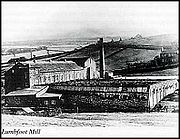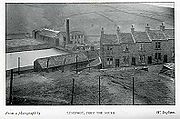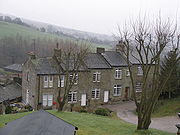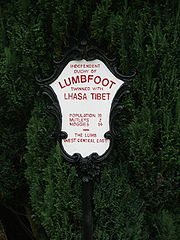
Lumbfoot
Encyclopedia
Lumbfoot is a hamlet
in the City of Bradford
metropolitan district, located a mile from Haworth
(England
) and five minute walking distance from Stanbury
. The hamlet itself overlooks some fields and a small stream. There are 15 households and a farm
within Lumbfoot. There is no public road, only a public footpath, and vehicles go in and out of Lumbfoot on a private road.
Lumbfoot has its own newspaper, The Lumbfoot Clarion, which reports on local news and events.
 The East row of cottages (built in 1852) is shown in the picture from an old postcard believed to date from the 1900's. It is interesting to compare this with a similar view taken recently. The cottages have been modernised but are still very recognisable.
The East row of cottages (built in 1852) is shown in the picture from an old postcard believed to date from the 1900's. It is interesting to compare this with a similar view taken recently. The cottages have been modernised but are still very recognisable.

. The Lumbfoot residents, led by Louis Shepherd, erected a road barrier and signs declaring independence, and used two stone outbuildings (former privies
) as a 'douane' and a 'gendarmerie'. This declaration of independence was reported in the county newspaper, the Yorkshire Post.
As part of the independence declaration, Lumbfoot was twinned with Lhasa, Tibet. The signpost shown in the photograph reads 'Lumbfoot, twinned with Lhasa, Tibet' and indicates the current number of residents - human, dogs (muttleys) and cats (moggies). Although the architect of the independence, Louis Shepherd, died in 1991, the current residents have actively maintained the policy.
Although the architect of the independence, Louis Shepherd, died in 1991, the current residents have actively maintained the policy.
Hamlet (place)
A hamlet is usually a rural settlement which is too small to be considered a village, though sometimes the word is used for a different sort of community. Historically, when a hamlet became large enough to justify building a church, it was then classified as a village...
in the City of Bradford
City of Bradford
The City of Bradford is a local government district of West Yorkshire, England with the status of a city and metropolitan borough. It is named after its largest settlement, Bradford, but covers a far larger area which includes the towns of Keighley, Shipley, Bingley, Ilkley, Haworth, Silsden and...
metropolitan district, located a mile from Haworth
Haworth
Haworth is a rural village in the City of Bradford metropolitan borough of West Yorkshire, England. It is located amongst the Pennines, southwest of Keighley and west of Bradford. The surrounding areas include Oakworth and Oxenhope...
(England
England
England is a country that is part of the United Kingdom. It shares land borders with Scotland to the north and Wales to the west; the Irish Sea is to the north west, the Celtic Sea to the south west, with the North Sea to the east and the English Channel to the south separating it from continental...
) and five minute walking distance from Stanbury
Stanbury
Stanbury is a small village in the metropolitan borough of the City of Bradford in West Yorkshire, England, west of Haworth, close to the Pennine Way, and on the River Worth. It is approximately 4 miles from the town of Keighley. The surrounding countryside is mainly moors and farmland, but the...
. The hamlet itself overlooks some fields and a small stream. There are 15 households and a farm
Farm
A farm is an area of land, or, for aquaculture, lake, river or sea, including various structures, devoted primarily to the practice of producing and managing food , fibres and, increasingly, fuel. It is the basic production facility in food production. Farms may be owned and operated by a single...
within Lumbfoot. There is no public road, only a public footpath, and vehicles go in and out of Lumbfoot on a private road.
Lumbfoot has its own newspaper, The Lumbfoot Clarion, which reports on local news and events.
History
The cottages at Lumbfoot were constructed between 1840 and 1852 to house the workers at Lumbfoot Mill in the floor of the valley. Originally water powered, the mill later adopted steam power evidenced by the tall chimney in the photograph from about 1900. The mill has since been largely demolished but a 15 foot stump of the chimney and the engine house (the small building next to the chimney) still remain. There is evidence of the pit that housed the original waterwheel among the ruins of the mill.


Declaration of independence
In 1989 Lumbfoot declared independence from the rest of the UK following a dispute between residents of Lumbfoot and residents of the nearby village, StanburyStanbury
Stanbury is a small village in the metropolitan borough of the City of Bradford in West Yorkshire, England, west of Haworth, close to the Pennine Way, and on the River Worth. It is approximately 4 miles from the town of Keighley. The surrounding countryside is mainly moors and farmland, but the...
. The Lumbfoot residents, led by Louis Shepherd, erected a road barrier and signs declaring independence, and used two stone outbuildings (former privies
Outhouse
An outhouse is a small structure separate from a main building which often contained a simple toilet and may possibly also be used for housing animals and storage.- Terminology :...
) as a 'douane' and a 'gendarmerie'. This declaration of independence was reported in the county newspaper, the Yorkshire Post.
As part of the independence declaration, Lumbfoot was twinned with Lhasa, Tibet. The signpost shown in the photograph reads 'Lumbfoot, twinned with Lhasa, Tibet' and indicates the current number of residents - human, dogs (muttleys) and cats (moggies).


